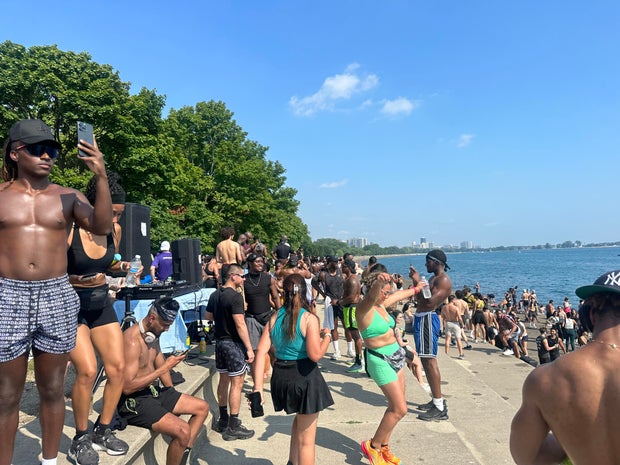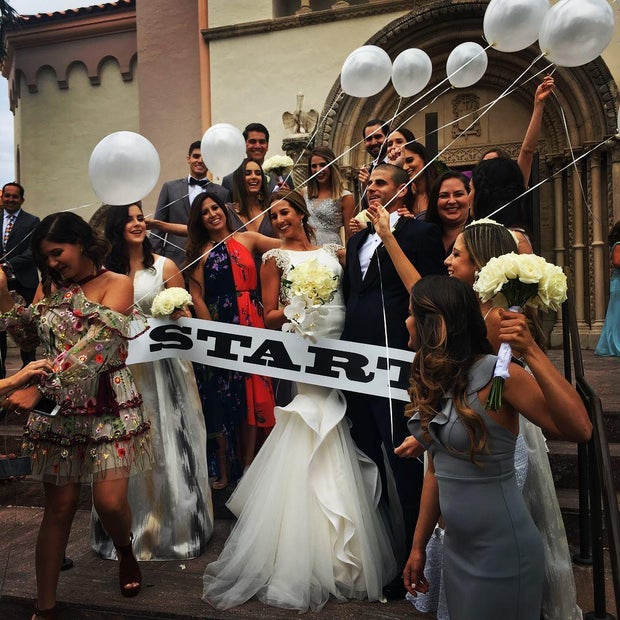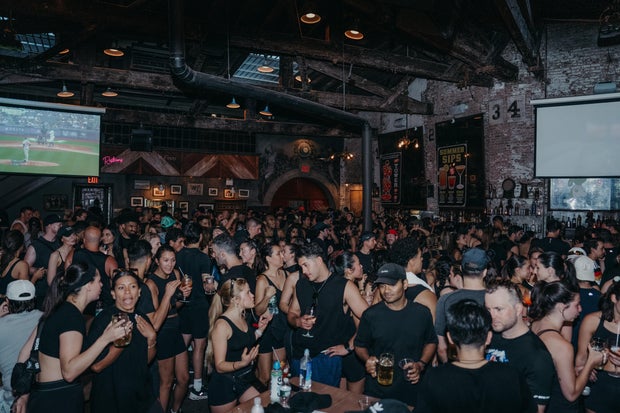CBS News
Why more single people are turning to run clubs and ditching dating apps

Tired of spending their days swiping through potential matches on dating apps, single people across the country are now hitting the pavement and joining run clubs as a fresh and active way to meet others.
For some, this means ditching the fluorescent blue light of a smartphone for the early morning sunshine.
At the Chicago Run Collective meeting point in Chicago, Illinois, hundreds of runners gather as early as 8 a.m. to stretch, warm up, and chat. For many, these morning runs offer an opportunity to connect with potential partners while staying fit and healthy.
“I am not a big runner, so I was a little bit nervous about joining. This is my first time here. Already, the vibes are positive, and I have gotten a couple of people to come up to me,” said Davawnna Clark, who mentioned she is taking a break from dating apps.
The shift from dating apps to running clubs has gained momentum through social media, with users on TikTok and Instagram chronicling their experiences. What began as a casual invitation among friends to join local running groups quickly evolved into a viral phenomenon.
As the trend gained traction, participants shared their stories online, showcasing the social and health benefits of trading swipes for sneakers. That caught the attention of established running clubs, which soon noticed an influx of newcomers.
Chicago Run Collective co-founders Maya Carducci and Jordan Williams leaned into this trend, creating a space where fitness and social interaction intersect.
“We wanted to join a run club ourselves for the summertime but couldn’t find any in Chicago that were focused on both running and socializing,” said Carducci. “A lot of the run clubs here are very focused on marathon training.”
Their club started in May and has quickly become a popular spot for runners looking to connect, with nearly 1,000 people showing up to run near Lake Michigan.
CBS News
The social media aspect of the club is a major component of its success.
“We’re on Instagram and TikTok, but predominantly Instagram. We push video content pretty hard and sell the lifestyle,” Carducci explained.
“People want to see the vibe on Instagram before they show up. It feels just like it does online,” added Williams.
The Chicago Run Collective has introduced creative signs to help participants break the ice, including one that says, “I am single, run with me.”
“We have had some direct messages from people who say, ‘Hey, I am single, I would love to meet someone at the run club,’ and we want to make sure that everyone has a chance to get their voice out,” said Williams. “So if you are single, you can grab a sign and walk around with it.”
CBS News
Carducci believes that run clubs offer a real-life alternative to dating apps, which don’t work for everyone.
“Some people operate better in real life, and if you are given an excuse to do something, you are more likely to do it, especially when it’s already attracting like-minded people,” Carducci said.
Williams added, “People want to see each other in their most raw state, no alcohol, in the morning. People have raw conversations that start out as friendships. We encourage people to make friends, but it can turn into more if you want it to. It’s a great first touchpoint.”
A love story on the run
Frankie Ruiz, the founder of the Brickell Run Club in Miami, understands from personal experience that you can meet the love of your life while running.
His now-wife, Carla Duenas, is an avid runner and she caught his eye at one of the events hosted by the South Beach Run Club.
“She reached out to me wanting to start a run club,” he recalls.
Ruiz, who launched his club in 2009, helped her establish the Weston Run Club, also in South Florida, guiding her through the logistics. Their shared passion for running turned into a deeper connection, leading to a proposal, marriage and two children.
“We run together now, and it’s part of our life. We even made running part of our wedding,” said Ruiz, who explained that their bachelor and bachelorette parties were half-marathon themed. “It’s not an obsession; it’s just part of who we are.”
Frankie Ruiz
Ruiz, who also co-founded Lifetime Miami Marathon, said his Brickell Run Club started as a modest group of five or six people in South Beach. It has since expanded to eight different run clubs, Brickell being the largest, attracting nearly 1,600 participants every week.
“We rarely think of the people being the real connection to feeling connected to a city. And I think that’s what the run clubs have brought to the table, especially since they’re free and they’re open and they’re inviting,” he said.
For Ruiz and his wife, their story is a testament that the power of running can bring like-minded people together. He said he encourages everyone to introduce themselves to two people at each meeting and take a moment to put their phones away.
“Running is how we met, and it’s how we stay connected,” he said. “It’s a beautiful thing to share with someone you love.”
However, while the charismatic run organizer loves telling newcomers how he found his soulmate in a run club, he says don’t let that fool you — he’s not running a dating service in disguise.
“I’ve always been cautious about labeling our run clubs as dating events,” Ruiz said. “I want people to come for the love of running and the community it fosters. If they happen to meet someone special, that’s a bonus.”
Finding community through fitness
Louisiana native Deuce Caston moved to Florida three and a half years ago. Currently working in health and life insurance sales, the 26-year-old has been transitioning into a full-time content creator. This led him to join a local run club, where fitness and social interaction intersect.
“I’ve been part of the run club for over a year now,” Caston said. “I genuinely enjoy running and wanted to be around like-minded people who share that interest.”
Caston joined the Off Balance Run Club in April 2023 after discovering it on TikTok. The club’s proximity to his home and the welcoming atmosphere made it a perfect fit for him.
“At the beginning, there were only about 15 to 20 of us,” he said.
The club has since grown, and Caston decided to have fun with the trend by posting a video to his social media followers, writing, “Done with dating apps and got good at running just to go to run clubs to find my wife.”
The video is just the tip of the iceberg in a sea of run club content flooding social media. Scroll through TikTok, Instagram, or even Facebook, and you’ll find countless stories of people lacing up their sneakers and hitting the pavement in search of a connection.
A run club with a dating twist
In New York City, the Lunge Run Club is upfront about wanting to serve as a connection point for single people.
Co-founder Steve Cole, who also created the Lunge app, said the club’s events are the “largest singles event New York has ever seen.”
“We saw how amazing run clubs are for community and meeting people,” he said. “Sometimes, you go for a run expecting to meet someone but end up too tired to talk. We wanted a community-first run club with a dating twist.”
The idea for Lunge came from Cole’s understanding of the dating challenges in New York.
“Dating is really hard in New York, and I think the dating apps make it even worse,” he said, adding, “I think all the big dating apps just emphasize endless swiping.”
Lunge Inc.
Lunge, which Cole co-founded with Rachel Lansing, hosts weekly runs every Wednesday and has runners who are single wear black and those who are taken wear white. The events start with a slow, conversational three-mile run or a 1.5-mile walk, followed by socializing at a bar.
“Our first run started off with like 20 to 30 people, and now we have 400-500 people at our events, which is insane,” Cole said. “It’s almost like a sight to see with that many singles in one place.”
Cole said the club’s growth has been entirely organic, with no paid ads, and he said that is part of its success.
“I think if you want to make a successful dating run club, your No. 1 priority has to be community,” he said. “And for us, there’s so many people who come alone, meet friends, and then come back next week with those friends.”
Success stories are plentiful.
“We get DMs all the time. It’s like, ‘Hey, I’ve been on six dates with this guy in the last two weeks that I met at Lunge Run Club,'” said Cole.
Cole said he understands the concern that run clubs might become known solely as dating venues.
“If you want a successful dating run club, your No. 1 priority has to be community. We’re a social club that runs, not just a run club. That distinction is important,” he said.
To foster interaction, Cole and Lansing encourage participants to introduce themselves to someone new before the run starts.
“It helps break the ice and ensures everyone has someone to talk to,” Cole explained.
The post-run bar social, dubbed #beersafter, is a highlight, providing a relaxed environment for attendees to mingle.
Flow State Creative
Despite the success, Cole remains focused on the mission.
“We want people to meet others who share their interests and live a healthy lifestyle. Our goal is to promote genuine connections, whether it’s through running or our app,” he said.
The decline of dating apps
Last year, Americans downloaded dating apps over 36 million times, a 16% decrease from 2020.
Dating coach Damona Hoffman, who wrote a book called “F the Fairy Tale,” told “CBS Mornings” that today’s dating app usage is characterized by rapid swiping and quick transitions to dates.
“It’s swipe, swipe, swipe, onto the date. Getting ghosted, getting frustrated, being burned out. Wash, rinse and repeat,” said Hoffman.
She has identified a trend she calls “zombie dating,” describing a growing disenchantment with online romance platforms.
The phenomenon includes compulsive profile browsing without intent to connect, simultaneously engaging with multiple potential partners, and using apps primarily for self-esteem boosts rather than relationship-building.
“A lot of these DMs and texts, they don’t go anywhere. So that’s really leading to the dating burnout because we get our hopes up,” Hoffman said. “Our adrenaline goes up and then it’s like withdrawal when the person doesn’t materialize into a date.”
Match Group, the parent company of several major dating apps, reported a decline in paid users across its platforms in its fourth quarter 2023 financial results.
The company saw a 5% year-over-year decrease in total paid users, falling to 15.2 million. Tinder, its flagship app, experienced an 8% drop to 10 million paid users. However, Hinge bucked the trend with a 33% increase, reaching 1.4 million paid users.
Despite this, the head of Match Group, which owns popular dating apps Tinder, OkCupid, Hinge and Match.com, expressed optimism about the company’s prospects despite recent challenges and that he expects to see the decline in paid users “moderating.”
CBS News
Terror expert: Leadership of Hezbollah has been “decapitated”

Watch CBS News
Be the first to know
Get browser notifications for breaking news, live events, and exclusive reporting.
CBS News
Starstruck: The public’s one-sided bond with celebrities

Watch CBS News
Be the first to know
Get browser notifications for breaking news, live events, and exclusive reporting.
CBS News
Brush with fame: The public’s one-sided bond with celebrities

Journalist Jancee Dunn admits it: She has been obsessed with rock star Stevie Nicks ever since high school. “I listened to Stevie’s music for hours and hours and hours,” she said. “I tried to dress, in an ill-advised moment, like Stevie! And she’s just kind of bound up in my early years in a way that is really intense and deeply personal.”
The years flew by, but her feelings never faded. So, imagine her joy when, in 1997, Harper’s Bazaar assigned her to interview Stevie Nicks at her California home!
Dunn began prepping immediately, rehearsing in front of a mirror how she would say “Hell-o, Stevie.”
Did Nicks understand what a fan she was? “I kept it together so I wouldn’t creep her out; I don’t think she fully knew what a fan that I was,” she said. “I knew to kind of pull it back!”
The interview even featured a surreal tour of the rock star’s closet, filled with capes she had worn on stage and her famous platform boots. Dunn said it was, indubitably, one of the happiest afternoons of her life. Her only keepsake: A precious autographed T-shirt that she stores folded in a special place in her closet.
CBS News
Asked if she ever though, This is fun, this is great, but Stevie’s just a person like me, Dunn replied, “No! No, why would I think that? It’s Stevie Nicks! Never did I think that, because it’s not true. She’s different. She’s otherworldly.”
Sociologist Kerry Ferris, a professor at Northern Illinois University, says our excitement over celebrities stems from them embodying things that we want for ourselves: “They have some combination of talent and good looks and wealth and renown,” she said.
Ferris has a database of dozens of celebrity encounter stories: “There’s a whole sort of category of encounters that involve physical contact, and fans really get excited about that: ‘I touched so-and-so.’ ‘I gave them a hug.’ ‘I shook their hand.’ ‘I sat next to them on the bus.’ And then, they get off the bus! It’s very fleeting. But it becomes the nugget of the celebrity-sighting story.”
Ferris said these stories typically follow a pattern. First comes disbelief (Is that really Beyoncé?), then strategizing (should I go introduce myself?), and then, often, embarrassment! “People get really worried about how stupid they must have sounded, looked or seemed,” Ferris said.
Psychologists refer to this kind of one-sided relationship as “parasocial.” University of Indianapolis professor Travis Cooper, who teaches in the philosophy and religion department, explains: “The fan is going to typically know a whole lot about the star, maybe their life history (depends on the level of their fandom). And the star is going to know nothing about that fan.”
The intensity of the feeling, Cooper said, is what makes such a relationship so mystifying. He should know – he’s had his own celebrity encounter.
One day, to his surprise, he spotted the actor Jesse Eisenberg at his local Y, an event he described as two worlds colliding: “I had my academic training, all that stuff kind of in my head that filters out how I see the world, all that on the one hand; and then on the other hand, I had this very visceral experience,” Cooper said. “There was a slight embarrassment, almost a giddiness, almost a fanboy kind of reaction at some point.”
He said he doesn’t consider himself a fanboy: “I’d like to not. But I feel like, in that moment, that’s kind of what happened.”
Even mention of a celebrity sighting or encounter is bound to stop the conversation. “It’s a brush with a person larger-than-life,” said Vance Ricks, a professor at Northeastern University in Boston. “And so, maybe some of the glory from that person rubs off on you.”
He says we therefore irrationally treasure these relationships. “It’s a little funny or ironic to call it a ‘relationship,’ when it’s so unidirectional,” he said. “What you’re often doing is projecting a sense of being understood by that person, or of knowing about that person.”
What does that tell us about the human condition? “Many of us want some kind of attachment,” Ricks said. “And in some cases, we may create that.”
Jancee Dunn felt that attachment, especially when – after she interviewed Stevie Nicks – the rock star graciously invited her to be an overnight house guest. “I thought, ‘Okay, should I? Shouldn’t I?’ It seemed invasive, it seemed weird. I said no, and I got in the cab. And as I’m pulling away, I mean, I couldn’t have been two blocks down the street where I thought, You idiot!”
She feels the same regret decades later, and even wrote about it for The New York Times, where she is a columnist for the Well section. “Even now, if I’m at the grocery store or the pharmacy, and I hear ‘Edge of Seventeen’ or one of Stevie’s hits, I get a pain in my heart,” she laughed.
What would Dunn like to tell Nicks today? “Stevie, if you were to invite me over to your house again, I would happily spend the night, I would clean up in the morning, and I would be a very good guest!” she laughed.
For more info:
Story produced by Amiel Weisfogel. Editor: George Pozderec.
See also:













